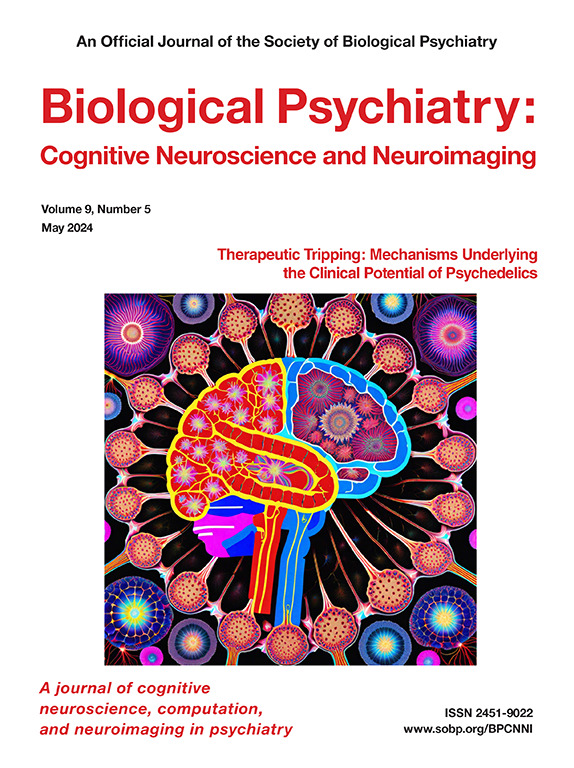通过多特征分析,破解神经解剖表型和精神疾病相互交织的遗传结构。
IF 4.8
2区 医学
Q1 NEUROSCIENCES
Biological Psychiatry-Cognitive Neuroscience and Neuroimaging
Pub Date : 2025-07-01
DOI:10.1016/j.bpsc.2024.08.018
引用次数: 0
摘要
背景:越来越多的证据表明,精神疾病和脑磁共振成像(MRI)表型之间存在共同的遗传因素。然而,破译这些结果的共同遗传结构已被证明具有挑战性,需要新的方法来推断这些表型的潜在遗传结构。多变量分析是揭示单变量方法所遗漏的 MRI 表型与精神疾病之间联系的一种有意义的方法:我们首先对 20K 名英国生物库参与者的九种 MRI 衍生脑容量表型进行了单变量和多变量全基因组关联研究(GWAS)。接下来,我们进行了各种互补性富集分析,以评估单变量和多特征方法是否以及如何区分六种精神疾病(双相情感障碍、注意缺陷/多动障碍(ADHD)、自闭症、精神分裂症、强迫症和重度抑郁障碍)中的障碍相关变异和非障碍相关变异。最后,我们使用优化的 k-medoids 方法,根据磁共振成像多特征相关性对顶级相关变异进行了聚类分析:结果:单变量核磁共振成像基因组学分析(Univariate MRI GWAS)显示出与精神疾病的遗传相关性微乎其微,而多特征基因组学分析(multitrait GWAS)则发现了多种新的关联,并显示出与多动症和精神分裂症相关的变异具有显著的富集性。聚类分析进一步发现了两个聚类,它们不仅富集了与多动症和精神分裂症相关的变异,而且效应方向一致。对这些聚类的功能注释分析表明了多种潜在机制,特别是神经营养素通路在核磁共振成像和精神分裂症中的作用:我们的研究结果表明,多特征关联特征可用于推断与精神疾病相关的基因驱动的潜在 MRI 变量,为未来生物标记物的开发开辟了道路。本文章由计算机程序翻译,如有差异,请以英文原文为准。
Multitrait Analysis to Decipher the Intertwined Genetic Architecture of Neuroanatomical Phenotypes and Psychiatric Disorders
Background
There is increasing evidence of shared genetic factors between psychiatric disorders and brain magnetic resonance imaging (MRI) phenotypes. However, deciphering the joint genetic architecture of these outcomes has proven to be challenging, and new approaches are needed to infer the genetic structures that may underlie those phenotypes. Multivariate analyses are a meaningful approach to reveal links between MRI phenotypes and psychiatric disorders missed by univariate approaches.
Methods
First, we conducted univariate and multivariate genome-wide association studies for 9 MRI-derived brain volume phenotypes in 20,000 UK Biobank participants. Next, we performed various complementary enrichment analyses to assess whether and how univariate and multitrait approaches could distinguish disorder-associated and non–disorder-associated variants from 6 psychiatric disorders: bipolar disorder, attention-deficit/hyperactivity disorder, autism, schizophrenia, obsessive-compulsive disorder, and major depressive disorder. Finally, we conducted a clustering analysis of top associated variants based on their MRI multitrait association using an optimized k-medoids approach.
Results
A univariate MRI genome-wide association study revealed only negligible genetic correlations with psychiatric disorders, while a multitrait genome-wide association study identified multiple new associations and showed significant enrichment for variants related to both attention-deficit/hyperactivity disorder and schizophrenia. Clustering analyses also detected 2 clusters that showed not only enrichment for association with attention-deficit/hyperactivity disorder and schizophrenia but also a consistent direction of effects. Functional annotation analyses of those clusters pointed to multiple potential mechanisms, suggesting in particular a role of neurotrophin pathways in both MRI phenotypes and schizophrenia.
Conclusions
Our results show that multitrait association signature can be used to infer genetically driven latent MRI variables associated with psychiatric disorders, thereby opening paths for future biomarker development.
求助全文
通过发布文献求助,成功后即可免费获取论文全文。
去求助
来源期刊

Biological Psychiatry-Cognitive Neuroscience and Neuroimaging
Neuroscience-Biological Psychiatry
CiteScore
10.40
自引率
1.70%
发文量
247
审稿时长
30 days
期刊介绍:
Biological Psychiatry: Cognitive Neuroscience and Neuroimaging is an official journal of the Society for Biological Psychiatry, whose purpose is to promote excellence in scientific research and education in fields that investigate the nature, causes, mechanisms, and treatments of disorders of thought, emotion, or behavior. In accord with this mission, this peer-reviewed, rapid-publication, international journal focuses on studies using the tools and constructs of cognitive neuroscience, including the full range of non-invasive neuroimaging and human extra- and intracranial physiological recording methodologies. It publishes both basic and clinical studies, including those that incorporate genetic data, pharmacological challenges, and computational modeling approaches. The journal publishes novel results of original research which represent an important new lead or significant impact on the field. Reviews and commentaries that focus on topics of current research and interest are also encouraged.
 求助内容:
求助内容: 应助结果提醒方式:
应助结果提醒方式:


